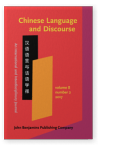Vol. 8:2 (2017) ► pp.212–243
A study of Chinese repetitive adverbs “hai (還)” and “zai (再)” from a cross-linguistic perspective
Comparisons of Chinese adverbs hai and zai is a long-standing topic in Chinese linguistics. Previous studies tend to mix up different uses of hai and zai, often leading to unnecessary confusion. This study focuses on the repetition use of these two adverbs, and demonstrates that in two syntactic environments – sentences with and without quantitative phrases – the nuances between hai and zai can both be captured by the hypothesis that “[+increasing]” is more essential for zai to deliver the repetition reading while “[+similar]” is more essential for hai to deliver the same reading. Based on conceptual correlations shared cross-linguistically, it is argued that the “[+similar]” feature facilitates the shift from the notion “inverted-sequence” to the notion “repetition” whereas the “[+increasing]” feature serves as an indispensable link between the notion “increment” and the notion “repetition”. Therefore, for the notion “repetition”, it is widely seen that a variety of languages use two devices to code it, one emphasizing the “[+similar]” feature and the other emphasizing the “[+increasing]” feature, and Chinese hai and zai is just one of such cases. In this way, the cross-linguistic perspective is proved to offer insights to explorations on language-specific issues as it provides accounts that are deep-rooted in the conceptual level.
Article outline
- 1.Introduction
- 2.A semantic feature analysis of hai and zai
- 2.1A semantic feature analysis of “repetition” and other related concepts
- Repetition
- Continuation
- Increment
- Inverted sequence
- 2.2The semantic behaviors of hai and zai in two syntactic environments
- 2.3The different devices of enabling the “repetitive” reading of zai sentences
- 2.4The differences of hai/zai and the “grounding” effect
- 2.1A semantic feature analysis of “repetition” and other related concepts
- 3.The two-way representations of “repetition” in Chinese and other languages
- 4.Discussion
- Acknowledgements
- Notes
-
References
